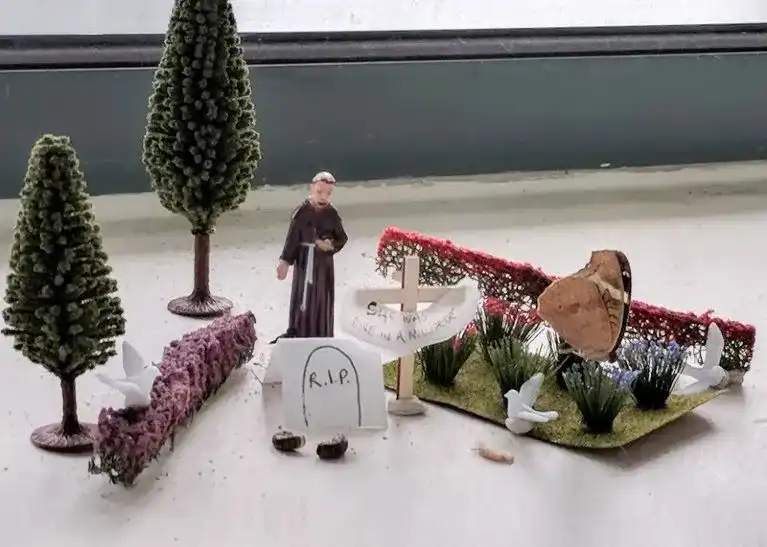Hoaxes fuel the joy of the laboratory, and scientific creation also benefits
The following article is from NCCareers Natural Workplace, author Nature Careers
 NCCareers Natural Workplace.
NCCareers Natural Workplace.
Nature Careers is Nature Portfolio's global career information resource and job search platform for scientific research talents. The average monthly users are 180,000, and the page views are 580,000. The content includes multiple sections such as job search and recruitment announcements, workplace information and career development suggestions.
Whether it's April Fools 'Day or any day of the year, pranks can allow scientists to think creatively while building team friendships.
original author:Amanda Heidt
Original based on Maple-scented cacti and pom-pom cats: How ranking at work can lift lab spirits The title was published in the careers section of Nature on March 27, 2024
On April 1, 2022, John Prensner, then a postdoctoral researcher in cancer biology, received a surprising letter. The letter, printed on seemingly official letterhead, outlines the Smithsonian Institution's plans for the Display of the Human Genome Project, which produced the first draft of the human genome sequence in 2001. The people who wrote the letter said they learned through professional connections that Prensner preserved part of this history on a workbench in his laboratories at the Massachusetts Institute of Technology and the Borders Institute at Harvard University in Cambridge, Mass.:The PTC-200 machine used for PCR reactions in early work.
The machine was "inherited" from a colleague at nearby Whitehead College, where most of the project's research was done; it is Prensner's favorite machine because it is so simple to operate. He only used one machine, the PTC-200, although it was about his age at the time. When it finally stopped working, Prensner took the machine apart and tried to repair it. But it never "woke up" and accumulated dust until the letter arrived. "I won't throw it away because I like it very much and I'm very excited that it might get a second life." He said,"Until I turned the letter over."

Non-malicious laboratory shenanigans, such as spraying unexpected odors on laboratory items or sticking a wide-eyed Google Eye, can lift spirits and promote connections within a research team.| Juj Winn/Getty
The Smithsonian Institution is also interested in outdated sound technology, including Prensner's almost unusable 1995 boombox, the letter states:A large portable slightly). Amid the atmosphere of his laboratory colleagues lurking around him, he quickly realized that the whole thing was probably a prank. "Fortunately, the atmosphere in the laboratory was very friendly and I didn't have any negative emotions." Prensner said, adding:When he went to the University of Michigan School of Medicine in Ann Arbor in 2023 to start building his laboratory, he threw away the PCR machine but kept the slightly and letter.
Such pranks are staged every day in the laboratory, and many of them have become departmental legends and circulated among several generations of students and faculty. It turns out that pranks are not just for fun, but can also play an important role-as a tool for community building, a channel for creativity in stressful work environments, and a way to pass on guidance. Although pranks can take almost any form, there are some basic principles that define whether and when pranks are appropriate. (Laboratory safety comes first:No researcher or experiment should have been injured as a result of a prank.)
"The foundation of a good prank is that you have to like and respect the target you are making fun of." Jess McLaughlin said that when she was a postdoctoral fellow in genomics at the University of California, Berkeley, she used to hide small plastic found in roadside boxes in various corners of their laboratory. "You're not here to cause pain to others-you're laughing with that person, not hurting them."
The prankster's script
Some scientists, including McLaughlin, will wait for a prank--when the opportunity arises. Others acted purposefully as pranks. Monica Tomaszewski, program director at the University of Pittsburgh in Pennsylvania, recalled sticking teacher chalk in college, but her mischievous talent really came into play while studying for a doctorate at the same university. She found that her now-retired consultant had a similar sense of humor. Because he is Canadian, Tomaszewski planned a prank to make his office smell like maple syrup. She bought a candle-scented solution and applied it every spring on his radiator, which houses his collection of about 70 cactus plants.
"His office smelled like syrup for weeks, but he didn't know why." Tomaszewski said. But one day, he quietly shared his conjecture with her-his cactus was in heat and releasing pheromones. "That's ridiculous because cactus has no mating cycle and he's a very smart biologist." she said. Tomaszewski nearly spoilt the prank at the time, but eventually persevered-she even handed over the scent solution to a lab colleague before moving on to her next job-and one day, a few years later, she finally confessed to her consultant over lunch.
This kind of "upward spoofing"-pranking against people in a position of authority-is one of the self-evident rules of many pranks, as well as "horizontal spoofing" against friends and colleagues. However, researchers interviewed by Nature said it was bad behavior to joke on people under power.
The social atmosphere also determines whether it is appropriate to engage in pranks. Jennifer Phillips, assistant researcher in genetics at the University of Oregon in Eugene, said it often depends on whether it is "at the right time, in the right place, with the right people." Not all laboratories support a culture of mischief, and team dynamics change as personnel change. But when Phillips joined the university in 1998 to pursue a doctorate,"the laboratory was made up of a unique group of people who really put the fun on the table." she said.
One hoax now underway involves a timer used to track experiments. As a courtesy, people quickly turn off the beeping alarm when the time is up to avoid disturbing others, but this doesn't always happen. The first violation may bring you some mild ridicule, but it quickly escalates to bribes with snacks to retrieve hidden timers, carving foul words into offending timers, and, at worst, embedding timers in agarose gel. Phillips said there are rare situations where people can't quickly understand (it's a prank).
Phillips said pranks help create a more equal environment. she said:"Playing makes it easier for everyone to approach each other when in doubt (asking for help)." She pointed out that this is especially true for her as a freshman. "On the other hand, we also have heated laboratory meetings where people go all out to study your data. University laboratory culture makes those criticisms seem more constructive rather than personal."
Indeed, researchers interviewed by Nature said that using humor to enhance social connections is a common reason for people to play pranks. For example, one day in 2006, Tomaszewski and her laboratory colleagues were cleaning out laboratory inventory when they discovered a bottle of calcium chloride solution, a month before the bottle's 21st birthday. Instead of throwing it away, they had a birthday party for it. "We put a little triangular birthday hat on it." She said they then went to a local bar called Filthy McNasty's to celebrate the solution's "adulthood"(21 is the legal minimum drinking age in the United States).
Although we do not encourage pranks on junior or newcomers, it is entirely reasonable for them to partner up in designing jokes. Back in 2015, independent paleontologist Lisa Buckley drew summer shift students into a long prank war between her and her husband, paleontologist Richard McCrea.
Buckley sees the move as a form of teamwork that strengthens an otherwise short-lived connection. She and her students printed photos of cats and made dozens of small pompous cats, spreading the cats around McCrea's offices at the Peace Area Palaeontology Research Center in Tabler Ridge, Canada, where the couple serves as curators. In retaliation for these "cat wars", McCrea launched a "spider web" attack-when Buckley returned from a week of field work, she found her office completely swallowed by fake spider webs and hundreds of fake spiders, including a giant spider on her desk and another hanging under it.
Years later, Buckley and McCrea both found cats and spiders in their belongings-pressed between pages or hidden in boxes-and continued to make surprises even after each left their new positions. Buckley said there may be more props hidden in the laboratory, as well as the Annoyatron noise generator she left on the ceiling, which regularly makes the chirping of crickets.
"I feel so sorry for those who have to live in these offices." she said.
Purpose of play
Playing pranks does take time and energy, but some scientists emphasize that a small drop in productivity is worth it because humor and play have many positive benefits, including relieving the stress of an academic career. A growing number of early-career researchers are facing the double whammy of stagnant wages and poor employment prospects. Researchers say pranks can serve as a pressure relief valve, allowing people to devote themselves fully to the work they are doing. "Doing something stupid in your laboratory, whether it's a prank or going out to sing karaoke, will make you remember that work is fun." Tomaszewski said.
Rachel Thayer is now a postdoctoral fellow in evolutionary biology at the University of California, Davis, and she had a similar experience while studying for a doctoral student at the University of California, Berkeley in 2018. In the stairwell Thayer had to walk into the laboratory, a dead millipede lay for weeks, until one day, a funeral scene suddenly appeared around it-including a tombstone, a priest and some bushes. Other students quickly added many things to the scene, usually model creatures that had long been "lost" in their work. Thayer contributed a butterfly used in structural color evolution research that inhabits with fruit flies and pill worms. "It makes the torturous staircase walking an inside joke." She added that it was "a relaxing, silent moment of sharing in what would otherwise be boring and repetitive parts of the day."

In Rachel Thayer's former laboratory building, a dead millipede inspired passers-by to create a memorial scene for it and bring other passed laboratory samples with them| Rachel Thayer
In fact, researchers enjoy recalling past pranks, especially those who claim to have grown into "boring, non-pranking adults." Daniel Bolnick, now an evolutionary biologist at the University of Connecticut at Storys, was a complete joker early in his career. He once placed a real rubber hand in a colleague's −80°C refrigerator, and as a student he designed a poster for a conference claiming to provide scientific evidence for the butterfly effect-an aspect of chaos theory that describes how the flapping of butterfly wings causes typhoons on the other side of the world. He watched as his prankster partner Evan Preisser, now a community ecologist at the University of Rhode Island in Kingston, showed off the work under a pseudonym. "Some people see that this is a joke, some people don't." "The latter group tried to educate us, and some of them were agitated because they knew we were talking nonsense but couldn't prove it," Presser said.
Bolnick said recalling the pranks felt like catharsis,"because it really reminded me of those times when scientific creativity was exerted." He added that he even felt he might have to start pranking again, even with some mild types of pranks. As it happens, some of his former students are now faculty members in his department-and as colleagues at the same workstation, he thinks it's a fair game. "It makes things easy-I know exactly who my first victim will be."
© nature
doi:10.1038/d41586-024-00951-7
© 2024 Springer Nature Limited. All Rights Reserved
an AI
What laboratory pranks have you experienced (planned)? Come and have fun on April Fool's Day?
Click to read the original text and view the original English text
本文经授权转载自NCCareers Natural Workplace(ID:NatureCareers),如需二次转载请联系原作者。欢迎转发到朋友圈。
